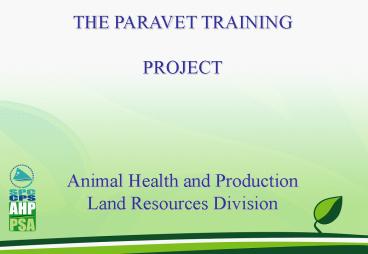The PARAVET Training Project - PowerPoint PPT Presentation
Title:
The PARAVET Training Project
Description:
THE PARAVET TRAINING PROJECT Animal Health and Production Land Resources Division Project Background Loss of production caused by livestock diseases and the risk of ... – PowerPoint PPT presentation
Number of Views:153
Avg rating:3.0/5.0
Title: The PARAVET Training Project
1
THE PARAVET TRAINING PROJECT Animal Health
and Production Land Resources Division
2
Project Background
- Loss of production caused by livestock diseases
and the risk of human being exposed to diseases
carried by animals are major obstacles to
development of livestock sector in the Pacific
Island Countries. - The development of livestock sector has been
complicated further by an acute shortage of
qualified veterinarians and animal production
specialists in the region.
3
Project Goals
- To train livestock workers to enable an increase
in animal productivity resulting in increased
income generating opportunities by - Controlling or preventing diseases
- Improving animal husbandry practices
- Protect public health by reducing exposure to
diseases carried by animals /or animal products
4
Project Goals contd
- Increase awareness of the dangers if introduction
of exotic diseases through training in disease
recognition and surveillance - Protect the environment by promoting
environmentally acceptable livestock farming
systems - Facilitate trade development by helping satisfy
WTO requirements for animal health information
5
The Demand for PARAVET
- The need was first identified in 1951 when the
development of regional approach to training
animal health care specialists was recommended - PHALPS X re-emphasised the need for
para-veterinary training and recommended that SPC
develop such training programmes - The recommendation was endorsed by the 16th
meeting of CRGA and the South Pacific Conference.
- This recommendation was subsequently endorsed by
PHALPS X111 and XIV the 28th Meeting of CRGA,
which is indicative of full government support
and also by later PHALPS. (Nadi, 2001)
6
The Demand for PARAVET contd
- A training needs assessment was carried out in 13
of the 22 member countries in 1998 - A MOU between ADAP SPC and USP was signed in
1999 in which the 3 institutions agreed to
collaborate in the development of a
Paraveterinary Training Programme to prevent
duplication
7
PHALPS following guidelines for the development
of the course
- Avoidance of residential courses
- Maximum use of in country trainers
- Maximum use of in-country facilities
- Minimum disruption of work related activities
8
What is a Paravet?
The paravet is the eyes and ears of the
veterinarian at the community level. A paravet is
not a qualified veterinarian but he is
responsible for providing animal health care and
animal production advice to people in their
communities.
9
Target Goals
- In the Pacific context, this training programme
is designed for people who work with animals but
have not had any formal training in animal health
or animal production This programme is intended
in particular for extension officers involved in
providing services to farmers in the field.
10
What will a Paravet do?
- Recognize signs of disease in animals
- Treat sick animals
- Advise farmers on correct livestock management
practices - Ensure that animals are slaughtered in a hygienic
and humane way
11
What will a Paravet do? Contd
- treat those sick animals that he can, given the
resources available to him and refer sick animals
to the nearest veterinarian if he is unable to
treat them - provide advice to members of the community on
animal production and health issues. - visit farmers and advise members of his community
on how to improve animal productivity - carry out surveillance for the introduction of
exotic diseases
12
How many Courses?
- Originally, it was planned that a total of 6
courses will be developed - Introductory course
- Pig and Poultry Animal Health and Production
- Ruminant Animal Health and Production
- Quarantine and Exotic Diseases
- Meat Hygiene and Food Safety
- Livestock and the Environment
13
Introduction Course
- Course manual developed and delivery commenced
- A 16 week course
- 2 Day orientation/launching
- ASSESSMENT
- 3 assignments 30 marks
- 1 week practical summer school 5 marks
- Written examination 50 marks
- Oral and practical examination 15 marks
14
Trainees in the field - Samoa
15
Samoa Practical Session
16
PARAVET Graduation Introductory Course Samoa
17
PARAVET PHOTOS
18
(No Transcript)
19
(No Transcript)
20
(No Transcript)
21
(No Transcript)
22
(No Transcript)
23
Written Paravet Exams in Saipan
24
Paravet Practical Demonstration in Saipan
25
(No Transcript)































